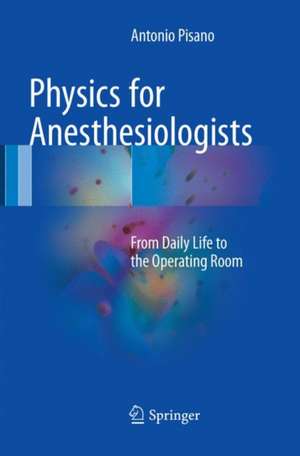Physics for Anesthesiologists: From Daily Life to the Operating Room
Autor Antonio Pisanoen Limba Engleză Paperback – 3 aug 2018
Each of the 16 chapters starts with an everyday phenomenon, explains it with a physical law, and then shows why that law is important in anesthesia practice. Numerous illustrations are included for extra clarity.
It is intended for anesthesiologists, intensivists, anesthesia teachers, anesthesia trainees, and medical students.
Preț: 575.78 lei
Preț vechi: 606.08 lei
-5% Nou
Puncte Express: 864
Preț estimativ în valută:
110.18€ • 115.32$ • 91.70£
110.18€ • 115.32$ • 91.70£
Carte tipărită la comandă
Livrare economică 27 martie-02 aprilie
Preluare comenzi: 021 569.72.76
Specificații
ISBN-13: 9783319861357
ISBN-10: 3319861352
Pagini: 171
Ilustrații: XIII, 171 p. 49 illus. in color.
Dimensiuni: 155 x 235 mm
Greutate: 0 kg
Ediția:Softcover reprint of the original 1st ed. 2017
Editura: Springer International Publishing
Colecția Springer
Locul publicării:Cham, Switzerland
ISBN-10: 3319861352
Pagini: 171
Ilustrații: XIII, 171 p. 49 illus. in color.
Dimensiuni: 155 x 235 mm
Greutate: 0 kg
Ediția:Softcover reprint of the original 1st ed. 2017
Editura: Springer International Publishing
Colecția Springer
Locul publicării:Cham, Switzerland
Cuprins
Preface.- Part I. Gases, bubbles and surroundings.- Perfect coffee and oxygen cylinders: the ideal gas law.- Boats, balloons, and air bubbles: Archimedes’ principle.- Air bubbles in the blood sample: better or worse oxygenation? Dalton’s law and Fick’s law .- Cold, sparkling drinks, and blood gas analysis: Henry’s law.- Bubbles, tracheal tube cuffs, and reservoir bags: surface tension and Laplace’s law.- Part II. Fluids in motion: masks, tubes, and hemodynamics.- The Venturi mask works like an airplane: Bernoulli’s theorem.- From tubes and catheters to the basis of hemodynamics: the Hagen–Poiseuille equation.- Part III. Hemodynamic monitoring.- Toothpaste, sea deeps, and invasive pressure monitoring: Stevin’s law and Pascal’s principle.- Heat, cardiac output, and what is the future: laws of thermodynamics.- Part IV. Forces in action.- Doors, steering wheels, and central venous catheters: the moment of a force (torque).- Friction, trigonometry, and Newton’s laws: all about Trendelenburg position.- Part V. Inhalation anesthesia.- Why a vaporizer is not exactly a vaporizer and why it weighs so much: saturated vapor pressure and heat of vaporization.- Thermal expansion: train tracks, thermostats and, again, vaporizers.- The voice of xenon: origin and propagation of sound.- Part VI. Electromagnetic waves.- Light, air pollution and pulse oximetry: the Beer-Lambert law.- Cerebral oximetry and why the sky is blue: Rayleigh scattering.- Catch me if you can: X-ray, Compton scattering and the inverse square law.- Part VII. Now we exaggerate.- Activated clotting time and… A brief look at the theory of relativity.
Recenzii
“Antoni Pisano provides a lot of useful information about physics in general and applied physics in anesthesia and critical care in specific. … this book is a perfect match for both junior residents and experienced staff members. One may read it for pleasure and enjoy the funny examples or use it to quickly review some formulas. It may be a good companion for both the couch at home and the operating room.” (Peter Markus Spieth, Anesthesia & Analgesia, Vol. 127 (2), August, 2018)
Notă biografică
Antonio Pisano is staff anesthesiologist and intensivist at the Cardiac Anesthesia and Intensive Care Unit of the Monaldi High Specialty and University Hospital, A.O. “Dei Colli”, Naples, Italy. His many scientific contributions include, among others, papers published in the New England Journal of Medicine, the Journal of the American Medical Association, Critical Care Medicine, Anesthesia & Analgesia, and the American Heart Journal. He is author of several book chapters in the field of anesthesiology, critical care medicine, and non-invasive ventilation, including a chapter of the 7th edition of the renowned Kaplan’s Cardiac Anesthesia. He is also co-editor of the book “Reducing Mortality in Acute Kidney Injury” published by Springer in 2016. Currently, he is principal investigator in several multicenter randomized trials and he collaborates with various international journals as a reviewer. Of course, he is also a great physics enthusiast!
Textul de pe ultima copertă
This book discusses, explains and provides detailed, up-to-date information on physics applied to clinical practice in anesthesiology, with the aid of simple examples from daily life. Almost everything that happens around us, including in the operating room and intensive care units, can be explained by physical laws. An awareness and understanding of relatively simple laws such as Bernoulli’s theorem, Hagen-Poiseuille equation and Pascal’s principle, to name just a few, offer anesthesiologists and intensivists fascinating insights into why they do what they do.
Each of the 16 chapters starts with an everyday phenomenon, explains it with a physical law, and then shows why that law is important in anesthesia practice. Numerous illustrations are included for extra clarity.
It is intended for anesthesiologists, intensivists, anesthesia teachers, anesthesia trainees, and medical students.
Each of the 16 chapters starts with an everyday phenomenon, explains it with a physical law, and then shows why that law is important in anesthesia practice. Numerous illustrations are included for extra clarity.
It is intended for anesthesiologists, intensivists, anesthesia teachers, anesthesia trainees, and medical students.
Caracteristici
Written by a clinician for clinicians
Provides insights into the phenomena and the functioning of devices that anesthesiologists encounter on a daily basis
Uses a “divulgatory” approach with numerous examples from daily life, making it an enjoyable read even for those who don’t usually like or understand physics
Provides insights into the phenomena and the functioning of devices that anesthesiologists encounter on a daily basis
Uses a “divulgatory” approach with numerous examples from daily life, making it an enjoyable read even for those who don’t usually like or understand physics
